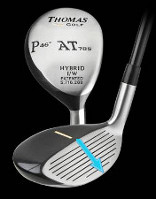
Loft
The term “loft” refers to the angle of the clubface which directly affects the trajectory and distance of the golf shot. It is an important aspect of golf club design and understanding loft is crucial for golfers to optimize their shots.
Loft is measured in degrees and is primarily used to describe the angle between the vertical face of the club and the ground when the club is held in a neutral position. The loft of a club greatly influences the initial launch angle of the ball and its ability to stay in the air during the flight. Clubs with higher lofts produce higher shots with more vertical trajectories, while clubs with lower lofts generate lower, more flatter shots that roll more upon landing.
Key Points:
- Loft is directly related to the loft angle of the clubface.
- Higher loft equals higher trajectory and increased vertical distance.
- Lower loft produces lower shots with increased roll on the ground.
The Importance of Loft
Understanding loft is essential when selecting the right club for a specific shot. Generally, golfers use the lowest lofted club that can reach the desired distance and trajectory. This is because lower lofted clubs, such as drivers, have less loft and produce longer shots when hit correctly. On the other hand, higher lofted clubs, such as wedges, provide increased loft to help the ball rise quickly and land softly.
Loft also affects the amount of backspin the ball generates upon impact. Clubs with higher lofts produce more backspin, resulting in shots that stop quickly upon hitting the ground. This is particularly useful for approach shots into the green, where golfers want to control the distance and prevent the ball from rolling too far.
Furthermore, loft contributes to the forgiveness of a club. Clubs with higher lofts have a more forgiving nature as they tend to minimize sidespin, making it easier for golfers to hit straight shots. This makes higher lofted clubs suitable for beginners or golfers who struggle with consistent ball contact.
Types of Clubs and Their Loft
Each type of golf club, including drivers, woods, hybrids, irons, and wedges, has different loft angles to serve various purposes during a round of golf. Here is an overview of the typical loft angles for different clubs:
- Driver: 8-12 degrees
- Woods (3-wood, 5-wood, etc.): 15-24 degrees
- Hybrids: 18-27 degrees
- Long Irons: 18-23 degrees
- Short Irons: 42-50 degrees
- Wedges: 50-60 degrees
It is important to note that loft angles may vary between different club manufacturers and models. Golfers should consult the specifications of their clubs to determine the exact loft of each club in their bag.
In Conclusion
Loft is a critical concept that affects the trajectory, distance, and accuracy of golf shots. Understanding loft allows golfers to select the appropriate club for each shot and optimize their performance on the course. By considering loft angles and their effects, golfers can make more informed decisions and improve their overall game.




